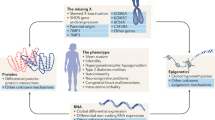Abstract
Introduction.
Müllerian agenesis, also named the Mayer-Rokitansky-Küster-Hauser syndrome (MRKHS) or vaginal aplasia, is the second most common cause of primary amenorrhea. It is characterized by the congenital absence of the Müllerian structures including the Fallopian tubes, the uterus, and the internal portion of the vagina in an otherwise normally feminized 46,XX subject. Most cases are sporadic in inheritance, but the occurrence of some patients with chromosomal translocations or even familial aggregates suggest a genetic basis for the disease, although the etiology of the disease is still unknown. It has been suggested that activating mutations in the anti-Müllerian hormone (AMH) or in its receptor (AMHRII) are potential sources for the defect.
Methods.
In this study we describe the molecular analysis of both the AMH and AMHR genes in a group of 15 patients with Müllerian agenesis. After sequencing all exons and exon/intron junctions of both genes, we were not able to detect any deleterious mutation.
Results.
Five new polymorphisms, 2 of them in the AMHRII gene and 3 of them in the AMH gene, were identified. No significant differences between patients and controls were observed in the frequency of a given polymorphism.
Conclusion.
This work reinforces the view that molecular defects in the AMH or AMHR are unlikely sources for the MRKHS syndrome.
Similar content being viewed by others
References
Allard S, Adin P, Gouédard L, di Clemente N, Josso N, Orgebin-Crist M-C, Picard J-Y, Xavier F (2000) Molecular mechanisms of hormone-mediated Müllerian duct regression: involvement of β-catenin. Development 127:3349–3360
Behringer RR, Cate RL, Froelick GJ, Palmiter RD, Brinster RL (1990) Abnormal sexual development in transgenic mice chronically expressing Müllerian inhibiting substance. Nature 345:167–170
Belville C, Josso N, Picard J-Y (1999) Persistence of Müllerian derivatives in males. Am J Med Genet 89:218–223
Bhagavath B, Stelling JR, van Lingen BL, Davis AJ, Reindollar RH, Gray MR (1998) Congenital absence of the uterus and vagina (CAUV) is not associated with the N314D allele of the galactose-1-phosphate uridyl transferase (GALT) gene [abstract]. J Soc Gynecol Invest 5:140
Carson SA, Simpson JL, Malinak LR, Elias S, Gerbie AB, Buttram BC, Sarto GE (1983) Heritable aspects of uterine anomalies. II. Genetic analysis of Müllerian aplasia. Fertil Steril 40:86–91
Cramer DW, Goldstein DP, Fraer C, Reichardt JK (1996) Vaginal agenesis (Mayer-Rokitansky-Küster-Hauser syndrome) associated with the N314D mutation of galactose-1-phosphate uridyl transferase (GALT). Mol Hum Reprod 2:145–148
Fore SR, Hammond CB, Parker RT, Anderson EE (1975) Urologic and genital anomalies in patients with congenital absence of the vagina. Obstet Gynecol 46:410–416
Griffin JE, Edwards C, Madden JD, Harrod MJ, Wilson JD (1976) Congenital absence of the vagina: the Mayer-Rokitansky-Küster-Hauser syndrome. Ann Intern Med 85:224–236
Heikkila M, Peltoketo H, Vainio S (2001) Wnts and the female reproductive system. J Exp Zool 290:616–623
Imbeaud S, Bellville C, Messika-Zeitoun L, Rey R, di Clemente N, Josso N, Picard J-Y (1996) A 27 base-pair deletion of the anti-Müllerian type II receptor gene is the most common cause of the persistent Müllerian duct syndrome. Hum Mol Genet 5:1269–1277
Kitajewsky J, Sasson D (2000) The emergence of molecular gynecology: homeobox and Wnt genes in the female reproductive tract. Bioessays 22:902–910
Knebelmann B, Boussin L, Gurerrier D, Legeai L, Kahn A, Josso N, Picard J-Y (1991) Anti-Müllerian hormone Bruxelles: a nonsense mutation associated with the persistent Müllerian duct syndrome. Proc Natl Acad Sci USA 88:3767–3771
Kucheria K, Taneja N, Kinra G (1988) Autosomal translocation of chromosomes 12q and 14q in Müllerian duct failure. Indian J Med Res 87:290–294
Lane AH, Donahoe PK (1998) New insights into Müllerian inhibiting substance and its mechanism of action. J Endocrinol 158:1–6
Lindenman E, Shepard MK, Pescovitz OH (1997) Müllerian agenesis: an update. Obstet Gynecol 90:307–312
Ludwig KS (1998) The Mayer-Rokitansky-Küster-Hauser syndrome. An analysis of its morphology and embryology. Arch Gynecol Obstet 262:1–26
Miller C, Sasson DA (1998) Wnt-7a maintains appropriate uterine patterning during the development of the mouse female reproductive tract. Development 125:3201–3211
Reindollar RH, Byrd JR, McDonough PG (1981) Delayed sexual development: a study of 252 patients. Am J Obstet Gynecol 140:371–380
Resendes BL, Sohn SH, Stelling JR, Tineo R, Davis AJ, Gary MR, Reindollar RH (2001) Role for anti-Müllerian hormone in congenital absence of the uterus and vagina. Am J Med Genet 98:129–136
Rock JA (1986) Anomalous development of the vagina. Semin Reprod Endocrinol 4:13–31
Shokier MHK (1978) Aplasia of the Müllerian system: evidence for probable sex-limited autosomal dominant inheritance. Birth Defects 14:147–165
Stelling J, Gray M, Davis A, van Lingen B, Reindollar R (1997) Müllerian agenesis: an update. Obstet Gynecol 90:1024–1025
Strubbe EH, Cremers CWRJ, Willemsen WNP, Rolland R, Thijn CJP (1994) The Mayer-Rokitansky-Küster-Hauser (CAUV) syndrome without and with associated features: two separate entities? Clin Dysmorphol 3:192–199
Teng YN, Wang TR, Hwu WL, Lin SP, Lee-Chen GJ (2000) Identification and characterization of −3c-g acceptor splice site mutation in human alpha-L-iduronidase associated with mucopolysaccharidosis type IH/S. Clin Genet 57:131–136
Van Lingen BL, Eccles MR, Reindollar RH, Gray MR (1998) Molecular genetic analysis of the PAX2 gene in patients with congenital absence of the uterus and vagina [abstract]. Fertil Steril 70:S402
Van Lingen BL, Reindollar RH, Davis AJ, Gray MR (1998) Further evidence that the WT1 gene does not have a role in the development of the derivatives of the Müllerian duct. Am J Obstet Gynecol 179:597–603
Acknowledgements.
This study was supported by the CONACYT grant # G28494 M. We are grateful to Dr. Ricardo Garcia-Cavazos for providing us with blood samples from his patients.
Author information
Authors and Affiliations
Corresponding author
Rights and permissions
About this article
Cite this article
Zenteno, J.C., Carranza-Lira, S. & Kofman-Alfaro, S. Molecular analysis of the anti-Müllerian hormone, the anti-Müllerian hormone receptor, and galactose-1-phosphate uridyl transferase genes in patients with the Mayer-Rokitansky-Küster-Hauser syndrome. Arch Gynecol Obstet 269, 270–273 (2004). https://doi.org/10.1007/s00404-002-0456-7
Received:
Accepted:
Published:
Issue Date:
DOI: https://doi.org/10.1007/s00404-002-0456-7




